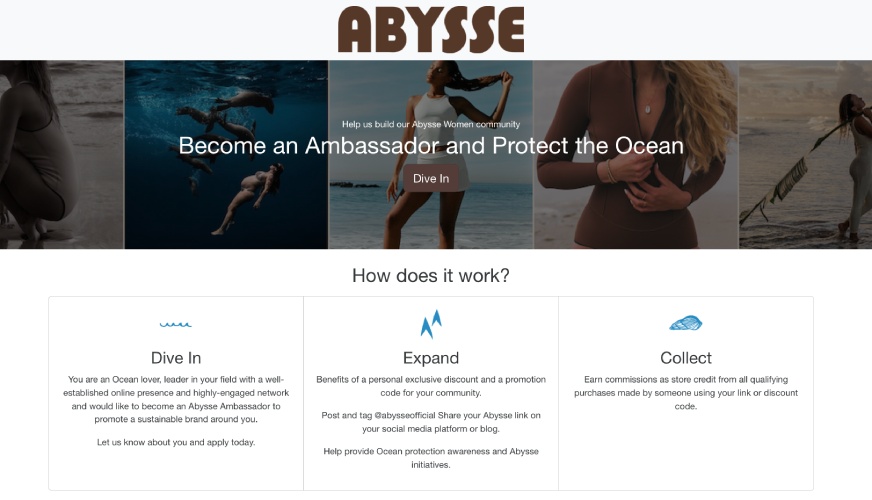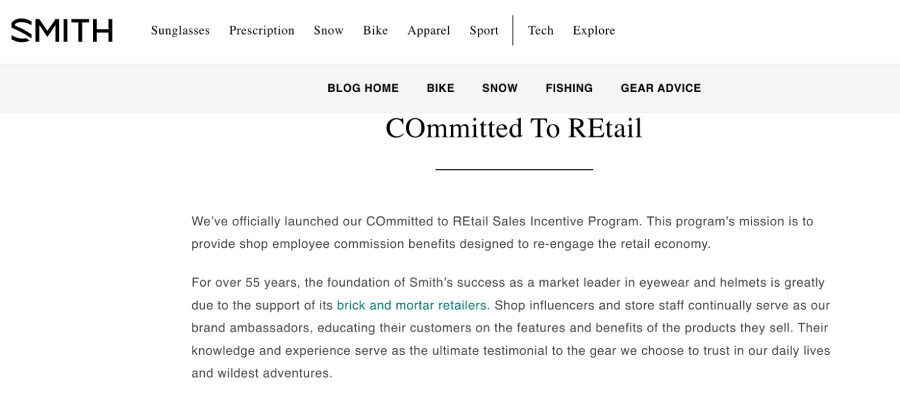Affiliate programs are one retail marketing strategy you can tap into to drive awareness and sales. It’s essentially a win-win professional relationship: Affiliates promote your brand, and you only pay them when they’ve successfully made a referral. The benefit for retailers is that you don’t have to pay them until they’ve successfully done the job.
Starting a retail affiliate program involves determining your goals, choosing an affiliate network and commission structure, creating policies, recruiting affiliates, and tracking performance. We discuss all the steps in detail below.
Step 1: Define Your Goals & Objectives
Clearly outline the goals you aim to achieve through the affiliate marketing program. This will help guide your efforts. Some potential goals for your affiliate marketing program might include the following:
- Boost brand awareness
- Drive website traffic
- Increase retail sales
- Grow your email subscriber list
Step 2: Choose an Affiliate Marketing Platform or Network
Determine whether you want to manage the program in-house or use an affiliate marketing platform or network. Platforms simplify tracking, reporting, and payments.
There are many affiliate marketing platforms out there. Each has its own set of features and strengths and weaknesses. Some top options include ShareASale, CJ Affiliate, and Rakuten Advertising.
Step 3: Set Commission Structures
Affiliate programs have payouts that are based on a commission structure. When setting your commission rates and structures, consider industry standards and your budget. You want to be competitive enough to attract strong affiliates, but not so much so that you’re cutting into your profit margins.
Each program has its own unique commission structure, and you might also have varying structures for different types of affiliates.
Types of Retail Affiliate Program Commission Structures
There are many different ways you can approach your commission payouts. You can also use a combination of models, such as a lower base commission with additional bonuses for reaching specific sales milestones or achieving higher conversion rates.
Affiliates earn a flat fixed amount for every sale generated through their referral, regardless of the total purchase amount. For instance, you might offer a $5 commission for every sale. This is a great model if you have high-value items—10% on a $1,000 sale is $100, which could be a pretty significant expense.
In this commission structure, shoppers don’t have to make a purchase for affiliates to earn a payout. You might pay affiliates for a specific action, such as a completed sale, lead, or sign-up. This is also performance-based, and the commission is earned when the desired action occurs. It’s a good model if your goals are more brand-oriented and less sales-driven.
Create different tiers for affiliates based on performance. Affiliates then earn different commission rates based on the corresponding tier. As affiliates reach higher sales volumes or achieve specific targets, their commission percentage may increase.
Some programs offer lifetime commissions, where affiliates earn a commission on all future purchases made by a customer they referred, not just the initial sale. This is especially applicable to subscription-based businesses.
You might set different commission rates for different product categories or individual products, based on factors like profit margins or promotional goals.
You can also offer additional bonuses or incentives for top-performing affiliates, such as reaching a certain number of sales within a given period.
Step 4: Create Affiliate Program Policies
Develop clear and comprehensive program policies, including terms of service, payment schedules, and any promotional guidelines. This helps establish expectations and ensures compliance.
It’s important to stay informed about legal requirements and industry regulations related to affiliate marketing. Make sure your program complies with these standards to avoid any legal issues.
Step 5: Set Up Tracking & Attribution
Implement tracking to accurately monitor affiliate activities. Provide affiliates with unique tracking links or promo codes to attribute sales or leads to their efforts.
Your affiliate marketing platform might already facilitate tracking and attribution. This is the easiest way to simplify this process.
Step 6: Recruit Affiliates
Actively recruit affiliates who align with your brand and target audience. You can reach out to influencers, bloggers, or industry partners. Highlight the benefits of your program and the value they can bring to their audience. More than a quarter of brands use bloggers in their affiliate marketing campaigns, for instance. You might even find people in your store.
Announce the launch of your affiliate program through various channels. Use your website, email newsletters, and social media to attract potential affiliates. Provide a compelling call to action for potential affiliates to join.
Step 7: Provide Training, Support & Promotional Materials
Offer training materials and support to help affiliates understand your products, brand messaging, and the best ways to promote them. Ensure ongoing communication and assistance.
Create high-quality promotional materials, such as banners, product images, and copy, that affiliates can use to market your products and store. Make these materials easily accessible through a dedicated affiliate portal.
You might even create a “brand kit” of sorts for your affiliates. Your brand kit can include any logo or branding files, high-resolution product photos and videos, and pre-approved copy and messaging that affiliates can simply copy and paste for their own purposes. You might also provide editable templates to maintain brand synergy and consistency.
Step 8: Handle Payments Promptly
Establish a consistent and timely payment schedule for affiliates. This builds trust and encourages affiliates to continue promoting your products.
If you’re using an affiliate platform, it might also include features to automate your commission payouts.
Step 9: Monitor & Optimize
Regularly monitor the performance of your affiliate program. Analyze key metrics such as clicks, conversions, and revenue. Identify top-performing affiliates and optimize the program based on insights gained. Identify areas for improvement and consider scaling the program by attracting more affiliates or expanding promotional efforts.
Examples of Retail Affiliate Programs
Amazon Associates is perhaps the most well-known example of affiliate marketing. In fact, it’s the largest affiliate network, with more than 20% market share of the approximately $15.7 billion market. Small businesses also have their own affiliate programs. Abysse Swimwear, for example, refers to its affiliates as “ambassadors.”

Abysse has an established affiliate program with commissions and benefits.
In retail, affiliates might be rewarded for simply driving a store visit, or you might only offer a commission if their referrals make a purchase. It’s up to you and how you structure your retail affiliate program.
Outdoor goods retailer REI has an affiliate program, though these are limited to its online sales—making it a great tactic for supporting the ecommerce side of your retail business. Sunglass brand Smith Optics has an affiliate program with a spin—its retail employees are the ones who earn the commission.

Smith Optics offers an affiliate program that rewards its employees.
You can get creative with your retail affiliate program and adjust it to support your specific business goals.
What Costs Can You Expect in Retail Affiliate Marketing?
Commission is the name of the game when it comes to affiliate marketing. You can expect to pay a percentage of the total sale for each affiliate referral. But the costs of retail affiliate marketing go beyond commission payouts. There are other associated expenses to cover:
- Affiliate network fees: If you use an affiliate network to manage your program, there might be associated fees. These fees cover the services provided by the network, including tracking, reporting, and managing relationships with affiliates. The global number of affiliate-marketing-related service offerings grew by 26% in 2021—there are around 10,000 firms with affiliate marketing services.
- Technology and tools: Investing in affiliate tracking software and tools helps you accurately monitor affiliate activities, track conversions, and calculate commissions. Some might require upfront or ongoing fees.
- Creative content and collateral: You might need to invest in creating promotional assets, banners, graphics, and other content for affiliates to use to market your brand. Providing affiliates with high-quality promotional materials can boost the success of the program.
- Affiliate recruitment and management: Identifying and recruiting affiliates, as well as managing ongoing relationships, requires time and effort. You may need to allocate resources for affiliate outreach, communication, and support.
- Legal and compliance costs: Ensuring the affiliate marketing program complies with legal regulations and industry standards may involve legal consultations and compliance management. This is especially important to avoid any legal issues related to marketing practices.
- Payment processing fees: When making commission payments to affiliates, you might also have to pay the payment processing fees. This varies.
Frequently Asked Questions (FAQs)
Click through the questions below for some of the most common questions about starting a retail affiliate program.
Even if you have no experience, you can explore affiliate programs as a marketing strategy. Decide on your objectives for the affiliate program and select an affiliate program network or platform that works best for you. From there, you can set commission structures, craft your program policies, and set up tracking and attribution. Then, recruit and train affiliates or partners, handle payments, and continue monitoring your program.
The main steps involved in setting up an affiliate sales program are choosing an affiliate program network, setting commission structures, creating a system to reward their efforts, recruiting and training affiliates, and continually optimizing your process.
A retail affiliate program is a marketing strategy retailers use to increase sales through partnerships with external individuals or entities known as affiliates. In this arrangement, affiliates promote the retailer’s products or services through various online channels, such as websites, blogs, social media, or email marketing.
- Content affiliates who focus on creating and sharing valuable content, such as blog posts, articles, reviews, or videos, to attract and engage their audience.
- Coupon and deal affiliates who promote discounts, deals, and promotional offers. They often publish coupon codes, special promotions, or limited-time offers to attract cost-conscious consumers.
- Influencers who leverage their social media presence and online influence to promote products or services. Influencers may showcase products in sponsored posts, unboxing videos, or other engaging content.
Bottom Line
Starting a retail affiliate program can be a lucrative strategy for driving awareness and sales—it’s a great opportunity to expand reach without upfront costs. A well-structured retail affiliate program can significantly contribute to your business growth, leveraging the power of partnerships to drive sales and enhance brand awareness in the competitive retail landscape.